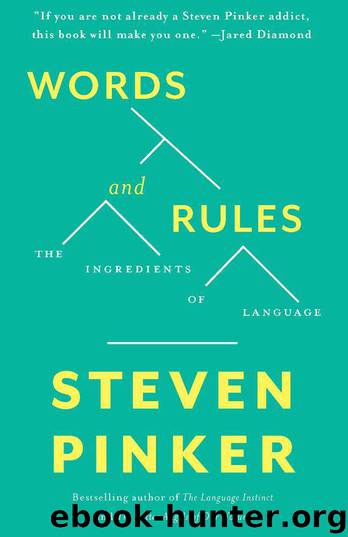Words and Rules by Steven Pinker

Author:Steven Pinker [Pinker, Steven]
Language: eng
Format: epub
ISBN: 9780465049714
Publisher: Basic Books
In science the pursuit of idle curiosity often pays off in deeper understanding. People’s inquisitiveness about flied out, talismans, sabertooths, still lifes, outputted, rat-infested, and other unexpected forms has enhanced our understanding of regularity and irregularity and provided an entirely new kind of evidence in favor of the words-and-rules theory.
The examples themselves show that regular and irregular forms are qualitatively different, not merely endpoints on a continuum of predictability. The regular pattern can apply to special words such as fly out and still life; the irregular patterns cannot. Irregular plurals can easily go inside compounds such as teethmarks and mice-infested; regular plurals cannot.
The examples also show that people consider more than sound when they form new words: An input sound like fly can emerge in the output as either flew or flied, depending on the person’s analysis of the whole word. But people consider more than meaning, too; a word’s meaning may be stretched to a wispy filament, as in threw up or cut a deal, and people will inflect it as if nothing had happened.
Instead, people are instinctive linguists, assigning a structure to every word. We all tacitly judge whether a word is a canonical root or some other kind of sound, and we analyze how the word may have been constructed from other words. The analyses that lie behind people’s choice of regular and irregular forms have deepened our understanding of the nature of words and rules. The most basic kind of word is a root, with a canonical sound arbitrarily paired with a meaning and a part of speech. The most basic action of rules is to compute the properties of a complex form from the properties of its parts and way they are arranged, with a special role for one position in the arrangement, the head.
Like many psycholinguists I have always thought of language in terms of rules and structures, but I was never sure I could defend the attitude against a hardened skeptic. It was only when I learned about the phenomena in this chapter that I became convinced that rules are living things inhabiting people’s minds. The theory that rules are a major ingredient of language offers a reasonable enough explanation for how we inflect new words, rare words, and unusual words. But when the theory also gives a click of insight into why we say lowlifes instead of lowlives and why teeth leave teethmarks but claws leave clawmarks, and ten other mysteries, it begins to take on the ring of truth. All the more so when it survives a wave of assaults by dangerous counterexamples.
The phenomena we have examined also provide us with a set of instruments to probe people’s mental representation of words when we turn in the coming chapters to three great challenges for the words-and-rules theory. Can we catch children in the act of learning a rule as they master their mother tongue? Do rules work in all the world’s languages the way they do in English? And can we
Download
This site does not store any files on its server. We only index and link to content provided by other sites. Please contact the content providers to delete copyright contents if any and email us, we'll remove relevant links or contents immediately.
Cecilia; Or, Memoirs of an Heiress — Volume 1 by Fanny Burney(32434)
Cecilia; Or, Memoirs of an Heiress — Volume 2 by Fanny Burney(31868)
Cecilia; Or, Memoirs of an Heiress — Volume 3 by Fanny Burney(31852)
The Lost Art of Listening by Michael P. Nichols(7403)
Asking the Right Questions: A Guide to Critical Thinking by M. Neil Browne & Stuart M. Keeley(5631)
We Need to Talk by Celeste Headlee(5542)
On Writing A Memoir of the Craft by Stephen King(4863)
Dialogue by Robert McKee(4321)
Pre-Suasion: A Revolutionary Way to Influence and Persuade by Robert Cialdini(4144)
I Have Something to Say: Mastering the Art of Public Speaking in an Age of Disconnection by John Bowe(3839)
Elements of Style 2017 by Richard De A'Morelli(3306)
The Book of Human Emotions by Tiffany Watt Smith(3237)
Fluent Forever: How to Learn Any Language Fast and Never Forget It by Gabriel Wyner(3025)
Name Book, The: Over 10,000 Names--Their Meanings, Origins, and Spiritual Significance by Astoria Dorothy(2938)
Good Humor, Bad Taste: A Sociology of the Joke by Kuipers Giselinde(2903)
Why I Write by George Orwell(2874)
The Art Of Deception by Kevin Mitnick(2735)
The Grammaring Guide to English Grammar with Exercises by Péter Simon(2706)
Ancient Worlds by Michael Scott(2622)
